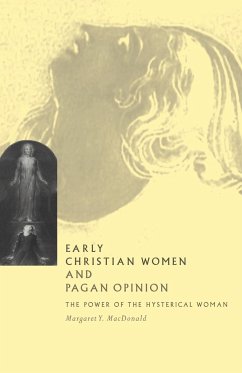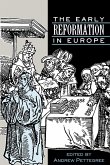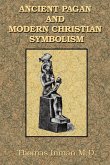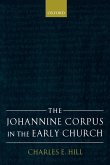- Broschiertes Buch
- Merkliste
- Auf die Merkliste
- Bewerten Bewerten
- Teilen
- Produkt teilen
- Produkterinnerung
- Produkterinnerung
Public reaction to the church, and its influence on the lives of early Christian women.
Andere Kunden interessierten sich auch für
![Hebrew, Jewish, and Early Christian Studies Hebrew, Jewish, and Early Christian Studies]() Heerak Christian KimHebrew, Jewish, and Early Christian Studies30,99 €
Heerak Christian KimHebrew, Jewish, and Early Christian Studies30,99 €![Amata's Choice Amata's Choice]() Cherie LassiterAmata's Choice20,99 €
Cherie LassiterAmata's Choice20,99 €![The Early Reformation in Europe The Early Reformation in Europe]() Andrew Pettegree (ed.)The Early Reformation in Europe51,99 €
Andrew Pettegree (ed.)The Early Reformation in Europe51,99 €![Ancient Pagan and Modern Christian Symbolism Ancient Pagan and Modern Christian Symbolism]() Thomas InmanAncient Pagan and Modern Christian Symbolism17,99 €
Thomas InmanAncient Pagan and Modern Christian Symbolism17,99 €![The Early Church and Today The Early Church and Today]() Everett FergusonThe Early Church and Today33,99 €
Everett FergusonThe Early Church and Today33,99 €![The Johannine Corpus in the Early Church The Johannine Corpus in the Early Church]() Charles E. HillThe Johannine Corpus in the Early Church103,99 €
Charles E. HillThe Johannine Corpus in the Early Church103,99 €![Early Church and Today volume 2 Early Church and Today volume 2]() Everett FergusonEarly Church and Today volume 234,99 €
Everett FergusonEarly Church and Today volume 234,99 €-
-
-
Public reaction to the church, and its influence on the lives of early Christian women.
Hinweis: Dieser Artikel kann nur an eine deutsche Lieferadresse ausgeliefert werden.
Hinweis: Dieser Artikel kann nur an eine deutsche Lieferadresse ausgeliefert werden.
Produktdetails
- Produktdetails
- Verlag: Cambridge University Press
- Seitenzahl: 292
- Erscheinungstermin: 31. Januar 2005
- Englisch
- Abmessung: 216mm x 140mm x 17mm
- Gewicht: 415g
- ISBN-13: 9780521567282
- ISBN-10: 0521567289
- Artikelnr.: 22325825
- Herstellerkennzeichnung
- Libri GmbH
- Europaallee 1
- 36244 Bad Hersfeld
- gpsr@libri.de
- Verlag: Cambridge University Press
- Seitenzahl: 292
- Erscheinungstermin: 31. Januar 2005
- Englisch
- Abmessung: 216mm x 140mm x 17mm
- Gewicht: 415g
- ISBN-13: 9780521567282
- ISBN-10: 0521567289
- Artikelnr.: 22325825
- Herstellerkennzeichnung
- Libri GmbH
- Europaallee 1
- 36244 Bad Hersfeld
- gpsr@libri.de
Introduction: 1. Defining the task
2. Women's studies in early Christianity and cultural anthropology
3. Honour and shame
4. Public, male/ private, female
5. A social-scientific concept of power
Part I. Pagan Reaction to Early Christian Women in the Second Century CE: 1. Pliny
2. Marcus Cornelius Fronto
3. Lucius Apuleius
4. Lucian of Samosata
5. Galen of Pergamum
6. Celsus
7. Conclusion
Part II. Celibacy, Women, and Early Church Responses to Public Opinion: 1. Paul's teaching on marriage as a 'conversionist' response to the world
2. Paul's focus on women holy in body and spirit in 1 Corinthians 7
3. A focus on women in light of the values of honor and shame
4. 1 Timothy 5.3-16 - second-century celibate women under public scrutiny
5. When the private becomes public - contacts between 1 Timothy 5.3-16 and the Acts of Paul and Thecla
Part III. Marriage, Women, and Early Church Responses to Public Opinion: 1.1 Corinthians 7.12-16 - the evangelising potential of household relations
2. 1 Peter 3.1-16 - recovering the lives of the quiet evangelists
3. Justin's woman married to an unchaste husband - religious sensiblities and life with a pagan husband
4. Married life and the social reality of women in the communities of Ignatius of Antioch
5. From Ephesians 5.21-33 to Ignatius, Letter to Polycarp 5.1-2 - the evolution of authority structures governing the lives of married women
6. The church-bride and married women as mediators between the church and the world
7. Conclusion
General conclusion.
2. Women's studies in early Christianity and cultural anthropology
3. Honour and shame
4. Public, male/ private, female
5. A social-scientific concept of power
Part I. Pagan Reaction to Early Christian Women in the Second Century CE: 1. Pliny
2. Marcus Cornelius Fronto
3. Lucius Apuleius
4. Lucian of Samosata
5. Galen of Pergamum
6. Celsus
7. Conclusion
Part II. Celibacy, Women, and Early Church Responses to Public Opinion: 1. Paul's teaching on marriage as a 'conversionist' response to the world
2. Paul's focus on women holy in body and spirit in 1 Corinthians 7
3. A focus on women in light of the values of honor and shame
4. 1 Timothy 5.3-16 - second-century celibate women under public scrutiny
5. When the private becomes public - contacts between 1 Timothy 5.3-16 and the Acts of Paul and Thecla
Part III. Marriage, Women, and Early Church Responses to Public Opinion: 1.1 Corinthians 7.12-16 - the evangelising potential of household relations
2. 1 Peter 3.1-16 - recovering the lives of the quiet evangelists
3. Justin's woman married to an unchaste husband - religious sensiblities and life with a pagan husband
4. Married life and the social reality of women in the communities of Ignatius of Antioch
5. From Ephesians 5.21-33 to Ignatius, Letter to Polycarp 5.1-2 - the evolution of authority structures governing the lives of married women
6. The church-bride and married women as mediators between the church and the world
7. Conclusion
General conclusion.
Introduction: 1. Defining the task
2. Women's studies in early Christianity and cultural anthropology
3. Honour and shame
4. Public, male/ private, female
5. A social-scientific concept of power
Part I. Pagan Reaction to Early Christian Women in the Second Century CE: 1. Pliny
2. Marcus Cornelius Fronto
3. Lucius Apuleius
4. Lucian of Samosata
5. Galen of Pergamum
6. Celsus
7. Conclusion
Part II. Celibacy, Women, and Early Church Responses to Public Opinion: 1. Paul's teaching on marriage as a 'conversionist' response to the world
2. Paul's focus on women holy in body and spirit in 1 Corinthians 7
3. A focus on women in light of the values of honor and shame
4. 1 Timothy 5.3-16 - second-century celibate women under public scrutiny
5. When the private becomes public - contacts between 1 Timothy 5.3-16 and the Acts of Paul and Thecla
Part III. Marriage, Women, and Early Church Responses to Public Opinion: 1.1 Corinthians 7.12-16 - the evangelising potential of household relations
2. 1 Peter 3.1-16 - recovering the lives of the quiet evangelists
3. Justin's woman married to an unchaste husband - religious sensiblities and life with a pagan husband
4. Married life and the social reality of women in the communities of Ignatius of Antioch
5. From Ephesians 5.21-33 to Ignatius, Letter to Polycarp 5.1-2 - the evolution of authority structures governing the lives of married women
6. The church-bride and married women as mediators between the church and the world
7. Conclusion
General conclusion.
2. Women's studies in early Christianity and cultural anthropology
3. Honour and shame
4. Public, male/ private, female
5. A social-scientific concept of power
Part I. Pagan Reaction to Early Christian Women in the Second Century CE: 1. Pliny
2. Marcus Cornelius Fronto
3. Lucius Apuleius
4. Lucian of Samosata
5. Galen of Pergamum
6. Celsus
7. Conclusion
Part II. Celibacy, Women, and Early Church Responses to Public Opinion: 1. Paul's teaching on marriage as a 'conversionist' response to the world
2. Paul's focus on women holy in body and spirit in 1 Corinthians 7
3. A focus on women in light of the values of honor and shame
4. 1 Timothy 5.3-16 - second-century celibate women under public scrutiny
5. When the private becomes public - contacts between 1 Timothy 5.3-16 and the Acts of Paul and Thecla
Part III. Marriage, Women, and Early Church Responses to Public Opinion: 1.1 Corinthians 7.12-16 - the evangelising potential of household relations
2. 1 Peter 3.1-16 - recovering the lives of the quiet evangelists
3. Justin's woman married to an unchaste husband - religious sensiblities and life with a pagan husband
4. Married life and the social reality of women in the communities of Ignatius of Antioch
5. From Ephesians 5.21-33 to Ignatius, Letter to Polycarp 5.1-2 - the evolution of authority structures governing the lives of married women
6. The church-bride and married women as mediators between the church and the world
7. Conclusion
General conclusion.








